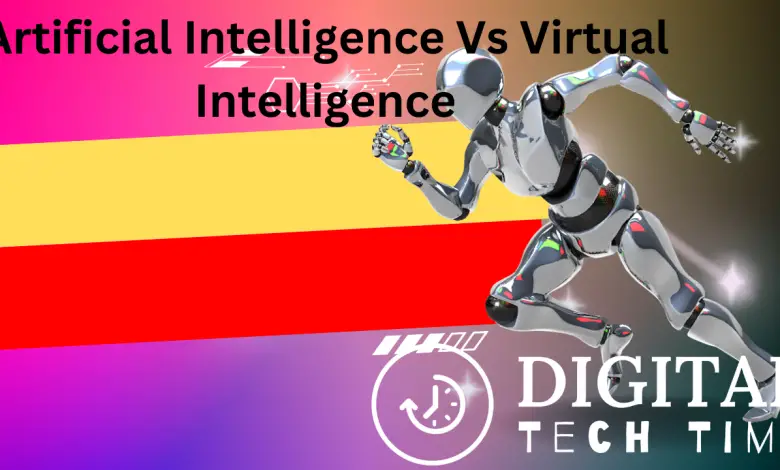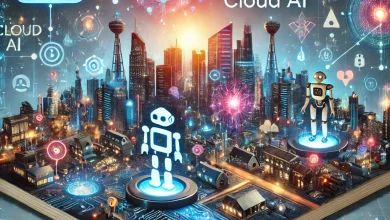Artificial Intelligence Vs Virtual Intelligence: A Clear Comparison
Unveiling the Differences: Artificial Intelligence Vs Virtual Intelligence

Artificial Intelligence (AI) and Virtual Intelligence (VI) are two terms that are often used interchangeably, but they are not the same thing. AI refers to the ability of machines to perform tasks that would typically require human intelligence, such as recognizing speech, making decisions, and solving problems. On the other hand, VI is a type of AI that is designed to simulate human-like intelligence in a virtual environment.
Understanding the differences between AI and VI is crucial as they have different implications and impacts on society. While AI is designed to perform specific tasks, VI is focused on creating a virtual environment that mimics human intelligence. AI is typically used in areas such as healthcare, finance, and transportation, while VI is used in gaming, simulation, and virtual reality.
Artificial Intelligence Vs Virtual Intelligence is a topic of debate in the tech industry. While AI is more widely used and has more practical applications, VI has the potential to revolutionize the way we interact with technology. As technology continues to advance, it is essential to understand the differences between the two and how they can be used to improve our lives.
Key Takeaways
- Artificial Intelligence (AI) and Virtual Intelligence (VI) are two distinct terms that refer to different types of technology.
- AI is designed to perform specific tasks, while VI is focused on creating a virtual environment that mimics human intelligence.
- While AI has more practical applications, VI has the potential to revolutionize the way we interact with technology.
Understanding Artificial Intelligence
Definition and Scope
Artificial Intelligence (AI) is a branch of computer science that deals with the development of intelligent machines that can perform tasks that typically require human intelligence. AI systems are designed to learn from experience, adapt to new situations, and make decisions based on data analysis. The scope of AI is broad, ranging from simple rule-based systems to complex deep learning algorithms.
Applications and Uses
AI has a wide range of applications across various industries. In healthcare, AI is used to diagnose diseases, develop treatment plans, and analyze medical images. In finance, AI is used for fraud detection, risk assessment, and investment management. In manufacturing, AI is used for predictive maintenance, quality control, and supply chain optimization. In transportation, AI is used for autonomous vehicles, route optimization, and traffic management.
Limitations and Challenges
Despite the many benefits of AI, there are also limitations and challenges that must be addressed. One of the main challenges is the lack of transparency and interpretability of AI systems. It can be difficult to understand how an AI system arrived at a particular decision, which can be a problem in applications where human lives are at stake. Another challenge is the potential for bias in AI systems. If the data used to train an AI system is biased, the system can perpetuate that bias in its decision-making. Finally, there are concerns about the impact of AI on employment. As AI systems become more advanced, there is a risk that they will replace human workers in certain industries.
In summary, AI is a powerful technology with a wide range of applications. However, as with any technology, it is important to be aware of its limitations and challenges. By addressing these issues, we can ensure that AI is used in a responsible and beneficial way.
Understanding Virtual Intelligence
Definition and Scope
Virtual Intelligence (VI) is a type of artificial intelligence that is designed to simulate human-like intelligence in a virtual environment. It is a subset of artificial intelligence that focuses on creating intelligent agents that can interact with virtual environments, such as video games, simulations, and virtual reality environments.
VI is often used to create intelligent agents that can perform specific tasks within a virtual environment, such as playing a game or navigating a virtual world. These agents are typically designed to be highly specialized and focused on a specific task, rather than being general-purpose like traditional AI systems.
Applications and Uses
VI has a wide range of applications, from video games and simulations to training and education. In video games, VI is used to create intelligent agents that can compete against human players or work alongside them as teammates. In simulations, VI is used to create realistic scenarios that can be used for training and research purposes.
VI is also used in education, where it can be used to create virtual tutors that can help students learn and practice new skills. These virtual tutors can adapt to the needs of individual students and provide personalized feedback and guidance.
Limitations and Challenges
One of the main limitations of VI is that it is often limited to specific virtual environments and tasks. This means that VI systems may struggle when faced with new or unexpected situations, as they are designed to operate within a specific context.
Another challenge with VI is that it can be difficult to create intelligent agents that are truly human-like in their behavior and decision-making. While VI systems can be highly specialized and focused on specific tasks, they may lack the flexibility and adaptability of human intelligence.
Despite these limitations, VI has the potential to revolutionize a wide range of industries and applications, from entertainment and education to healthcare and beyond. As technology continues to advance, it is likely that we will see more and more sophisticated VI systems that are capable of performing increasingly complex tasks in virtual environments.
Artificial Intelligence Vs Virtual Intelligence
Comparative Analysis
Artificial Intelligence (AI) and Virtual Intelligence (VI) are two distinct concepts that are often confused with each other. AI is the development of machines that can perform tasks that typically require human intelligence, such as problem-solving, decision-making, and language understanding. VI, on the other hand, is the creation of an intelligent virtual agent that can interact with humans in a natural language interface.
One of the key differences between AI and VI is their ability to learn and adapt. AI systems are designed to learn from data and improve their performance over time, whereas VI systems are programmed to respond to specific inputs and follow a set of rules. This makes AI more flexible and adaptable to new situations, while VI is more predictable and controlled.
Interplay and Interconnection
Despite their differences, AI and VI are not mutually exclusive concepts. In fact, they can complement each other in various ways. For example, AI can be used to improve the performance of VI systems by providing them with more data and insights. Similarly, VI can be used to enhance the user experience of AI systems by providing a more natural and intuitive interface.
Another area where AI and VI intersect is in the development of chatbots and virtual assistants. These systems use a combination of AI and VI to provide users with personalized and responsive interactions. By leveraging natural language processing and machine learning algorithms, these systems can understand user intent and provide relevant information and recommendations.
Future Perspectives
The future of AI and VI is promising, with both technologies expected to play a significant role in shaping the way we live and work. AI is already being used in various industries, such as healthcare, finance, and transportation, to improve efficiency and productivity. VI, on the other hand, is still in its early stages of development but has the potential to revolutionize the way we interact with technology.
As AI and VI continue to evolve, we can expect to see more sophisticated systems that are capable of performing complex tasks and providing more personalized experiences. However, it is important to be mindful of the ethical and social implications of these technologies, such as privacy concerns and job displacement. By addressing these issues proactively, we can ensure that AI and VI are developed and used in a responsible and beneficial manner.
Implications and Impact
Societal Impact
The implications of Artificial Intelligence (AI) and Virtual Intelligence (VI) on society are profound. These technologies have the potential to revolutionize the way we live and work, but they also raise serious ethical concerns. One of the main concerns is the impact that AI and VI will have on employment. As these technologies become more advanced, they will be able to automate many jobs that are currently done by humans. This could lead to widespread unemployment and social unrest.
Another concern is the potential for AI and VI to be used in ways that are harmful to society. For example, these technologies could be used to create autonomous weapons that could be used to harm civilians. Additionally, AI and VI could be used to create highly realistic fake videos and audio recordings, which could be used to spread disinformation and propaganda.
Industry Impact
The impact of AI and VI on industry is already being felt. These technologies are being used to automate many tasks that were previously done by humans. For example, AI and VI are being used to automate customer service, data entry, and even medical diagnosis. This has the potential to increase efficiency and reduce costs, but it also raises concerns about job displacement.
Another potential impact of AI and VI on industry is the creation of new industries and business models. As these technologies become more advanced, they will create new opportunities for entrepreneurs and investors.
Personal Impact
The impact of AI and VI on individuals is also significant. These technologies have the potential to improve our lives in many ways. For example, AI and VI could be used to create personalized healthcare plans that are tailored to an individual’s unique needs. Additionally, these technologies could be used to create more efficient transportation systems, reducing travel time and improving safety.
However, there are also concerns about the impact of AI and VI on personal privacy. These technologies are capable of collecting vast amounts of data about individuals, which could be used for nefarious purposes if not properly protected.
Overall, the impact of AI and VI on society, industry, and individuals is complex and multifaceted. While these technologies have the potential to revolutionize the way we live and work, they also raise serious ethical concerns that must be addressed.
Conclusion
In conclusion, the field of Artificial Intelligence is rapidly advancing, and it is important to understand the differences between Artificial Intelligence and Virtual Intelligence. While both are designed to mimic human intelligence, they have distinct differences in terms of their capabilities and limitations.
Artificial Intelligence is designed to be more general and flexible, with the ability to learn from data and make decisions based on that data. It is often used in complex systems such as self-driving cars, medical diagnosis, and natural language processing.
On the other hand, Virtual Intelligence is more specialized and predictable. It is often used in systems that require specific rules and procedures, such as chatbots and virtual assistants. Virtual Intelligence is also more controlled and planned, making it easier to predict its behavior and outcomes.
It is important to note that both Artificial Intelligence and Virtual Intelligence have their own strengths and weaknesses. While Artificial Intelligence can be more flexible and adaptable, it can also be more difficult to control and predict. Virtual Intelligence, on the other hand, is more predictable and controllable but can be limited in its capabilities.
As the field of AI continues to evolve, it is likely that we will see a greater integration of both Artificial Intelligence and Virtual Intelligence in various systems and applications. By understanding the differences between these two types of intelligence, we can better design and implement AI systems that are effective, efficient, and safe.
Frequently Asked Questions
What is virtual intelligence and how does it differ from artificial intelligence?
Virtual intelligence (VI) is a type of artificial intelligence (AI) that is designed to simulate human-like thinking and decision-making processes in virtual environments. Unlike AI, which focuses on real-world tasks and applications, VI is primarily used in virtual worlds and simulations.
Can virtual intelligence be used for the same tasks as artificial intelligence?
While VI and AI share some similarities, they are designed for different purposes. AI is typically used for real-world tasks such as speech recognition, image processing, and data analysis. VI, on the other hand, is used for tasks such as virtual training simulations, gaming, and virtual assistants.
What are some examples of virtual intelligence applications?
Some examples of VI applications include virtual training simulations for military and medical personnel, virtual reality gaming environments, and chatbots and virtual assistants such as Siri and Alexa.
How does virtual intelligence compare to machine learning?
Machine learning is a subset of AI that focuses on teaching machines to learn and improve from experience. VI, on the other hand, is focused on simulating human-like thinking and decision-making processes in virtual environments. While there is some overlap between the two, they are designed for different purposes.
What are the benefits and limitations of virtual intelligence compared to artificial intelligence?
One of the key benefits of VI is its ability to simulate complex human-like thinking processes in virtual environments. This makes it ideal for tasks such as virtual training simulations and gaming. However, VI is limited in its real-world applications and is not as widely used as AI.
In what ways can virtual intelligence and artificial intelligence be used together?
Virtual intelligence and artificial intelligence can be used together in a variety of ways. For example, VI can be used to simulate virtual environments for AI systems to train and improve in. Additionally, AI can be used to enhance VI systems by providing more advanced decision-making capabilities.





